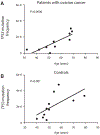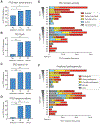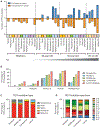Ultra-Sensitive TP53 Sequencing for Cancer Detection Reveals Progressive Clonal Selection in Normal Tissue over a Century of Human Lifespan
- PMID: 31269435
- PMCID: PMC6639023
- DOI: 10.1016/j.celrep.2019.05.109
Ultra-Sensitive TP53 Sequencing for Cancer Detection Reveals Progressive Clonal Selection in Normal Tissue over a Century of Human Lifespan
Abstract
High-accuracy next-generation DNA sequencing promises a paradigm shift in early cancer detection by enabling the identification of mutant cancer molecules in minimally invasive body fluid samples. We demonstrate 80% sensitivity for ovarian cancer detection using ultra-accurate Duplex Sequencing to identify TP53 mutations in uterine lavage. However, in addition to tumor DNA, we also detect low-frequency TP53 mutations in nearly all lavages from women with and without cancer. These mutations increase with age and share the selection traits of clonal TP53 mutations commonly found in human tumors. We show that low-frequency TP53 mutations exist in multiple healthy tissues, from newborn to centenarian, and progressively increase in abundance and pathogenicity with older age across tissue types. Our results illustrate that subclonal cancer evolutionary processes are a ubiquitous part of normal human aging, and great care must be taken to distinguish tumor-derived from age-associated mutations in high-sensitivity clinical cancer diagnostics.
Keywords: Duplex Sequencing; TP53, clonal evolution; aging; early detection; gynecologic oncology; high-grade serous ovarian cancer; next-generation sequencing; somatic mutations; uterine lavage.
Copyright © 2019 The Authors. Published by Elsevier Inc. All rights reserved.
Conflict of interest statement
DECLARATION OF INTERESTS
J.J.S. and L.A.L. are founders and equity holders at TwinStrand Biosciences. J.J.S., C.C.V., L.N.W., and J.E.H. are employees and equity holders at TwinStrand Biosciences. P.S. is a founder and equity holder in Ovartec. R.Z. is a founder and equity holder in Oncolab GmbH. R.A.R. shares equity in NanoString Technologies and is the principal investigator in an NIH Small Business Innovation Research (SBIR) subcontract research agreement with TwinStrand Biosciences. Commercial uses of Duplex Sequencing are protected by multiple patents held or licensed by the University of Washington and TwinStrand Biosciences. Commercial uses of uterine lavage for cancer screening and diagnosis are protected by multiple patents licensed or held by the Medical University of Vienna and Ovartec.
Figures







Similar articles
-
Uterine lavage identifies cancer mutations and increased TP53 somatic mutation burden in individuals with ovarian cancer.Cancer Res Commun. 2022 Oct;2(10):1282-1292. doi: 10.1158/2767-9764.crc-22-0314. Epub 2022 Oct 27. Cancer Res Commun. 2022. PMID: 36311816 Free PMC article.
-
Ultra-deep sequencing detects ovarian cancer cells in peritoneal fluid and reveals somatic TP53 mutations in noncancerous tissues.Proc Natl Acad Sci U S A. 2016 May 24;113(21):6005-10. doi: 10.1073/pnas.1601311113. Epub 2016 May 5. Proc Natl Acad Sci U S A. 2016. PMID: 27152024 Free PMC article.
-
Characterization of TP53 mutations in Pap test DNA of women with and without serous ovarian carcinoma.Gynecol Oncol. 2020 Feb;156(2):407-414. doi: 10.1016/j.ygyno.2019.11.124. Epub 2019 Dec 12. Gynecol Oncol. 2020. PMID: 31839337 Free PMC article.
-
Cancer-Associated Mutations but No Cancer: Insights into the Early Steps of Carcinogenesis and Implications for Early Cancer Detection.Trends Cancer. 2019 Sep;5(9):531-540. doi: 10.1016/j.trecan.2019.07.007. Epub 2019 Aug 22. Trends Cancer. 2019. PMID: 31474358 Free PMC article. Review.
-
Clinical Outcomes of TP53 Mutations in Cancers.Cold Spring Harb Perspect Med. 2016 Sep 1;6(9):a026294. doi: 10.1101/cshperspect.a026294. Cold Spring Harb Perspect Med. 2016. PMID: 27449973 Free PMC article. Review.
Cited by
-
Uterine lavage identifies cancer mutations and increased TP53 somatic mutation burden in individuals with ovarian cancer.Cancer Res Commun. 2022 Oct;2(10):1282-1292. doi: 10.1158/2767-9764.crc-22-0314. Epub 2022 Oct 27. Cancer Res Commun. 2022. PMID: 36311816 Free PMC article.
-
Mutational profiling of micro-dissected pre-malignant lesions from archived specimens.BMC Med Genomics. 2020 Nov 18;13(1):173. doi: 10.1186/s12920-020-00820-y. BMC Med Genomics. 2020. PMID: 33208147 Free PMC article.
-
TP53 somatic evolution in cervical liquid-based cytology and blood from individuals with and without ovarian cancer and BRCA1 or BRCA2 germline mutations.Oncogene. 2024 Jul;43(31):2421-2430. doi: 10.1038/s41388-024-03089-y. Epub 2024 Jun 25. Oncogene. 2024. PMID: 38918516 Free PMC article.
-
Pathogenic postzygotic mosaicism in the tyrosine receptor kinase pathway: potential unidentified human disease hidden away in a few cells.FEBS J. 2021 May;288(10):3108-3119. doi: 10.1111/febs.15528. Epub 2020 Sep 5. FEBS J. 2021. PMID: 32810928 Free PMC article. Review.
-
Broadening the spectrum of cancer genes under selection in human populations.FASEB Bioadv. 2021 Mar 27;3(4):275-277. doi: 10.1096/fba.2020-00150. eCollection 2021 Apr. FASEB Bioadv. 2021. PMID: 33842852 Free PMC article. No abstract available.
References
-
- Abyzov A, Tomasini L, Zhou B, Vasmatzis N, Coppola G, Amenduni M, Pattni R, Wilson M, Gerstein M, Weissman S, et al. (2017). One thousand somatic SNVs per skin fibroblast cell set baseline of mosaic mutational load with patterns that suggest proliferative origin. Genome Res. 27, 512–523. - PMC - PubMed
-
- Alix-Panabières C, and Pantel K (2016). Clinical Applications of Circulating Tumor Cells and Circulating Tumor DNA as Liquid Biopsy. Cancer Discov. 6, 479–491. - PubMed
Publication types
MeSH terms
Substances
Grants and funding
LinkOut - more resources
Full Text Sources
Medical
Research Materials
Miscellaneous

